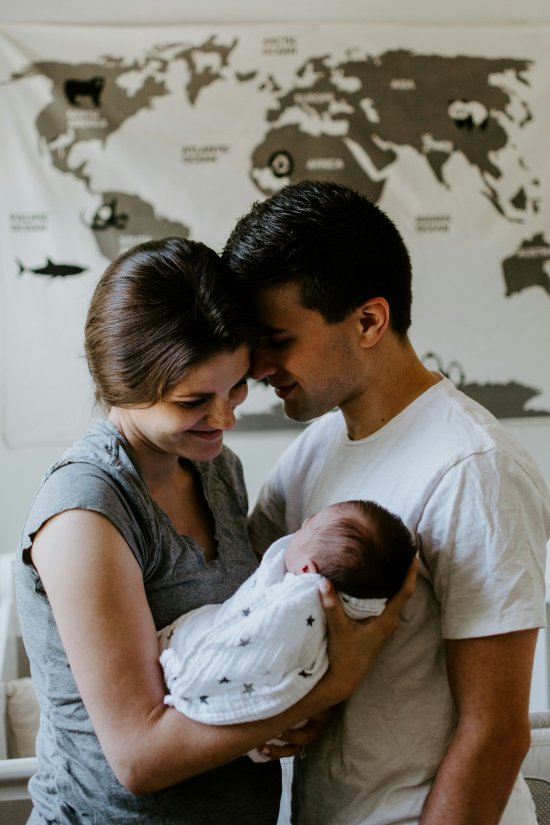
Welcoming a newborn into the world is an unparalleled experience, filled with moments of tender closeness and bonding that begin with a simple, yet profound act: holding your baby. This guide explores the art of holding your baby, which is foundational to their emotional and physical development. The warmth of your embrace, the rhythm of your heartbeat, and the gentle sway of your movements are all familiar comforts to your baby, reminiscent of their time in the womb.
Understanding the Basics
Holding your baby is not just about physical support but about creating a nurturing environment that fosters security and love. The head and neck of a newborn are delicate, requiring gentle support until they gain muscle strength. Recognizing your baby’s cues—such as fussing, crying, or turning their head—helps you understand their needs and comfort levels. Safety is paramount when picking up or laying down your baby, ensuring a smooth transition that avoids any sudden movements.
First, always support their head and neck! If they are laying down, gently scoop your arms underneath their body to put one hand under their head and neck and one under their bottom. When you’ve got a good hold, bring the baby closer to your own body.
Traditional Holds Explained
Each traditional hold serves a unique purpose in your baby’s daily life:
– Cradle Hold: This quintessential pose not only facilitates a deep emotional connection but also provides a stable base for your baby. The cradle hold is ideal for soothing, with your arms forming a natural cocoon that mirrors the snugness of the womb. In this hold you are using the inside of your arm to support the baby’s back, neck, and head.

Image: devon divine via unsplash
– Shoulder Hold: Perfect for burping after feeding, the shoulder hold places your baby high on your chest, allowing you to gently pat their back. This position offers the dual benefit of comforting your baby while ensuring their head is supported and elevated, which is particularly beneficial for babies prone to reflux. It’s also just a great way to snuggle together.

Image: Hollie Santos via Unsplash.
– The Belly Hold: This hold is a really helpful position for gassy babies. Gently lay your baby’s chest across one of your forearms and you’ll use your hand to hold them securely and your other arm can hold them across their back. Their arms and legs will hang over each side.

Photo © Sally Anscombe/Getty Images
– The Football Hold: This hold can also be a feeding position as you can use it while sitting or standing. In this hold, you support your baby’s neck and head with your hand and rest her back on the same forearm. The baby will curl toward you with their legs extended.

Kelly Sikkema via Unsplash
Holding Your Baby While Breastfeeding
Breastfeeding is a unique bonding experience, though finding the right position is crucial for both comfort and effective feeding. The cradle, cross-cradle, football hold, and laid-back nursing positions offer versatility to meet the changing needs of you and your baby. Each position supports different aspects of breastfeeding, from latch to comfort, and can be adapted as your baby grows.

If you are struggling to find a comfortable breastfeeding position or your little one is having a hard time latching, we recommended contacting a lactation consultant, or an IBCLC to support you! La Leche League is a great resource to find breastfeeding support.
 How To Hold A Baby After Feeding?
How To Hold A Baby After Feeding?
After the feeding, keep your baby upright and pat them until they burp. Do not indulge in activities such as jiggling, playing, or bouncing with your little one right after the feed. It may lead to spitting up.
Keeping your little one upright after a feeding is especially important for little ones with colic or reflux. Babywearing is a great resource to support you with this! Not only can you nurse in your baby carrier, but you can also keep them in the carrier afterward which puts them naturally in an upright position.
Babywearing Basics for Holding Your Baby
Babywearing, an ancient practice now supported by modern science, reinforces the bond between parent and child while promoting physical development. Ergobaby carriers are designed with this in mind, offering ergonomic support for both you and your baby. From front inward carries for newborns to back carries for older children, babywearing facilitates a closeness that is emotionally and developmentally beneficial.
Baby carriers are so helpful to give your body support when you’re carrying baby often. It helps relieve pressure from your back and shoulders and keeps your baby in a healthy position for comfort and development!
Here are the different ways you can carry your baby in baby carriers:
| Carry Position | Age and Developmental Milestones | Best Ways to Use |
| Front Inward Carry | Newborn-+ | Front inward carry is the most common carry and is best all day, every day. Consider it for bonding, resting, or calming a fussy baby. |
| Front Outward Carry | 6 months+
Must have good head and neck control |
This carry is best used for short amounts of time to protect the caregivers back. It’s convenient for around the house, quick errands, or adventures where your little one wants to engage with their surroundings. |
| Back Carry | 6 months +
Must have good head and neck control |
Back carry is great for walks, hikes, running errands, and other adventures. |
| Hip Carry | 6 months +
Must have good head and neck control |
Hip carry is a convenient option for when your little one wants to see your face, but you need more flexibility. Like doing household chores, grocery shopping etc… |
Learn more about Ergobaby carriers and how to wear them.
All Ergobaby carriers come with a free babywearing consultation! So, if you’re new to babywearing or want to try a new carry position, you can schedule a consultation with our babywearing experts to perfect your carry!
Debunking Myths and Addressing Concerns
It’s common for new parents to hear myths about baby holding, such as the idea that too much holding spoils a baby. However, research shows that responsive parenting, including holding your baby when they need comfort, leads to secure attachments and better emotional regulation as they grow.
Read more about Attachment Theory and the Continuum Concept.
Ergobaby’s Role in Your Baby-Holding Journey
Ergobaby is committed to supporting parents with products that enhance the natural act of holding your baby. From innovative carriers to expertly designed swaddles, Ergobaby products are here to make every moment of closeness more comfortable and fulfilling.
Holding your baby is an art form, blending instinct with technique to provide comfort, security, and love. By understanding the various holds and their benefits, you can ensure your baby thrives in the warmth of your embrace. Trust in your instincts, and remember, every cuddle, every gentle sway, is a step towards a strong, enduring bond.



